Ecologie Evolutive
Le département d'Ecologie Evolutive rassemble des compétences complémentaires en écologie comportementale, dynamique des populations, biologie des populations, écologie communautaire et méthodologie (statistiques et modélisation). Les recherches menées dans le département visent à étudier la façon dont les espèces animales évoluent dans un environnement variable en comprenant les causes de l'évolution des traits, des adaptations et des interactions. Pour cela, nous considérons différents niveaux d'organisation : individus, populations, communautés. Comme les organismes ne peuvent pas être considérés comme isolés des autres facteurs biotiques, nous considérons les pathogènes mais aussi les espèces en compétition au sein des communautés.
Nous étudions comment les individus s'adaptent à leur environnement qui est largement impacté par les pressions anthropiques, et comment les traits d’histoire de vie et le comportement évoluent en réponse à ces pressions. Bien que nous nous intéresserons principalement au phénotype, nous considérons de plus en plus le lien mécaniste entre le génotype et le phénotype. Nous développons le cadre théorique de notre discipline par une approche conceptuelle et de modélisation. En parallèle, nous testons les hypothèses qui découlent des prédictions théoriques par des approches expérimentales, comparatives et observationnelles sur différents modèles biologiques (insectes, oiseaux, mammifères). Les approches expérimentales sont développées en laboratoire (modèles insectes) et en milieu naturel (modèles oiseaux, insectes et mammifères). Les études observationnelles et comparatives concernent principalement les vertébrés. Nos approches s'intéressent également, et de plus en plus, aux mécanismes des réponses adaptatives. En plus des approches classiques d'analyse démographique et de changement de traits, des méthodes d'écophysiologie, d'écologie chimique et de biologie moléculaire sont utilisées.
Notre département porte également plusieurs suivis à long terme sur les populations sauvages de différentes espèces. Ces études à long terme offrent un moyen précieux de comprendre comment les facteurs biotiques et abiotiques affectent les traits d’histoire de vie des individus, et le fonctionnement des populations naturelles. Cinq populations d'espèces de mammifères sont ainsi suivies depuis plusieurs années (plus de 40 ans pour les chevreuils, 30 ans pour les marmottes des Alpes, 25 ans pour les chats, 16 ans pour les zèbres et 20 ans pour les impalas). Deux de nos sites d'étude, La Sassière dans le Parc national de la Vanoise (marmottes des Alpes) et le Parc national du Hwange, ont été certifiés "Site d'Etude en Ecologie Globale" (SEEG), et deux (ZA "Hwange" et ZA "Antarctique et sub-Antarctique") ont été certifiés "Zone Atelier" par le CNRS.
Le département d'écologie évolutive est également largement impliqué dans les activités de formation. Enfin, nous avons également des relations socio-économiques fortes. Nous abordons des questions d'intérêt sociétal majeur (réchauffement climatique, santé publique) et nous collaborons donc étroitement avec des partenaires socio-économiques (Office Français de la Biodiversité, Parc National de la Vanoise, Parc National de Hwange au Zimbabwe, Office National des Forêts, etc.) et participons à des événements grand public et médiatiques.
Publications
Affichage des publications 2101 à 2130 sur 2457 au total
Morphological evolution, ecological diversification and climate change in rodents
Proceedings of the Royal Society of London . 272 : 609-617
Article dans une revue
voir la publicationFirst upper molar and mandible shape of wood mice (Apodemus sylvaticus) from northern Germany: ageing, habitat and insularity
Mammalian Biology: Zeitschrift für Säugetierkunde . 70 ( 3 ) : 157-170
Article dans une revue
voir la publicationCoupling principal component analysis and GIS to map deer habitats
Wildlife Biology . 11 : 363-370
Article dans une revue
voir la publicationLa sarcosporidiose bovine
Bulletin des G.T.V. . 32 : 27-32
Article dans une revue
voir la publicationStatut sanitaire des ongulés sauvages de montagne – relation avec le statut sanitaire des ongulés domestiques
Réunion de présentation des actions de recherche. Parc Naturel Régional du massif des Bauges .
Acte de congrès
voir la publicationIsofemale lines in Drosophila: an empirical approach to quantitative trait analysis in natural populations
Heredity . 94 : 3-12
Article dans une revue
voir la publicationFunctional diversity of soil microbial community, rock phosphate dissolution and growth of Acacia seyal as influenced by grass-litter and soil-feeding termite nest structure amendments
Geoderma . 124 : 349-361
Article dans une revue
voir la publicationMADE4: an R package for multivariate analysis of gene expression data
Bioinformatics . 21 : 2789-2790
Article dans une revue
voir la publicationMolecular phylogeny of the African pygmy mice, subgenus Nannomys (Rodentia, Murinae, Mus): Implications for chromosomal evolution
Molecular Phylogenetics and Evolution . 36 ( 2 ) : 358-369
Article dans une revue
voir la publicationSystematics and evolution of the subfamily Gerbillinae (Mammalia, Rodentia, Muridae)
Molecular Phylogenetics and Evolution . 35 ( 3 ) : 674-688
Article dans une revue
voir la publicationCytotoxic T Cell Responses against Mesothelioma by Apoptotic Cell-pulsed Dendritic Cells
American Journal of Respiratory and Critical Care Medicine . 169 ( 12 ) : 1322-1330
Article dans une revue
voir la publicationEtude de maladies abortives non réglementées chez les ongulés sauvages de montagne et les ruminants domestiques des Bauges (Pré-Alpes du Nord, France). 22èmes Rencontres du Groupe d’Étude sur l’Écopathologie de la Faune Sauvage de Montagne
22èmes Rencontres du Groupe d’Étude sur l’Écopathologie de la Faune Sauvage de Montagne .
Acte de congrès
voir la publicationEcotoxicologie aquatique et modélisation des effets biologiques. Rapport final
: 55
Rapport
voir la publicationFood availability effect on population dynamics of the midge Chironomus riparius: a Leslie modeling approach
Ecological Modelling . 175 ( 3 ) : 217-229
Article dans une revue
voir la publicationLes modèles matriciels de type Leslie : Une approche couplée Mathématiques et Statistiques
incollection . -- : 377-392
Article dans une revue
voir la publicationAntibodies to Aleutian Mink Disease Parvovirus in free-ranging small carnivores from south-western France: implication for the conservation of the European mink (Mustela lutreola)
Journal of wildlife diseases . 40 : 394-402
Article dans une revue
voir la publicationIs there geographical variation in human handedness?
Laterality . 9 : 35-52
Article dans une revue
voir la publicationStudent athletes claim to have more sexual partners than other students
Evolution and Human Behavior . 25 : 1-8
Article dans une revue
voir la publicationAn age-dependent model describing the spread of panleucopenia virus within feline populations.
Banach Center Publications Polish Academy of Science . 63 : 197-207
Article dans une revue
voir la publicationSimultaneous analysis of a sequence of paired ecological tables with the STATICO method
Ecology . 85 : 272-283
Article dans une revue
voir la publicationMathématiques et Informatique du Vivant " : une formation interdisciplinaire qui voit le jour grâce au LMD
21ème congrès de l'AIPU (Association internationale de pédagogie universitaire) . : 1820-1822
Acte de congrès
voir la publicationSimple table for estimating confidence interval of discrepancy frequencies in microbiological safety evaluation
Journal of Microbiological Methods . 56 : 137-139
Article dans une revue
voir la publicationLife history traits and genome structure: aerobiosis and G+C content in bacteria
Lecture Notes in Computer Science . 3039 : 679-686
Article dans une revue
voir la publicationThe effects of hurricane Lothar on habitat use of roe deer
Forest Ecology and Management . 195 : 237-242
Article dans une revue
voir la publicationDynamics of production of sexual forms in Aphids: theoretical and experimental evidence for adaptive "Coin-flipping" plasticity
The American Naturalist . 163 : E112-E125
Article dans une revue
voir la publicationMolecular and behavioural analyses reveal male-biased dispersal between social groups of domestic cats
Ecoscience . 11 : 175-180
Article dans une revue
voir la publicationEffective size of two feral domestic cat populations (Felis catus L.): effect of the mating system
Molecular Ecology . 13 ( 2 ) : 483-490
Article dans une revue
voir la publicationMorphological variation of Palmatolepis Devonian conodonts: species versus genus
General Paleontology . 3 : 1-8
Article dans une revue
voir la publicationCoccolith size increase of Calcidiscus leptoporus offshore Morocco during the Last Glacial Maximum: an expression of enhanced glacial productivity ?
J. Nannoplankton Res. . 26 : 1-12
Article dans une revue
voir la publicationSize distribution of Holocene planktic foraminifer assemblages: biogeography ecology and adaptation
Marine Micropaleontology . 50 : 319-338
Article dans une revue
voir la publication






Vous aussi, commentez cet article